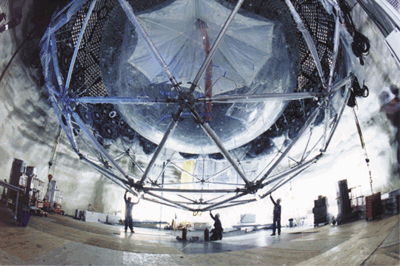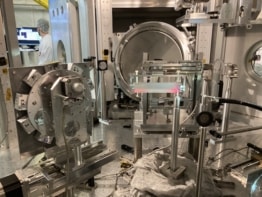New evidence that solar neutrinos can change “flavour” confirms that our understanding of the Sun is correct and that neutrinos have mass.

The first results from the Sudbury Neutrino Observatory in Canada have finally solved a problem that has puzzled astrophysicists for 30 years: why do experiments detect less than half the number of solar neutrinos predicted by models of the Sun? The results confirm that electron neutrinos produced by nuclear reactions inside the Sun “oscillate” or change flavour on their journey to Earth. Neutrino oscillations are only possible if the three flavours of neutrino – electron, muon and tau – have mass. The SNO result therefore has important implications for cosmology and particle physics.
Although the SuperKamiokande experiment in Japan has seen strong evidence for the disappearance of “atmospheric neutrinos” – neutrinos that are produced when cosmic rays interact with nuclei in the Earth’s atmosphere (Physics World July 1998 pp17-18) – the SNO results are significant because, when combined with solar-neutrino data from SuperKamiokande, they show for the first time that the disappearance of one neutrino flavour is accompanied by the appearance of another. This is the key signature of neutrino oscillations. The new results are also in excellent agreement with the predictions of standard solar models.
The SNO collaboration includes physicists from 15 centres in Canada, the US and the UK, and the results were presented on 18 June at the annual conference of the Canadian Association of Physicists in Victoria, and at seminars at Oxford University in the UK and the University of Pennsylvania in the US. They have also been submitted to the journal Physical Review Letters. “It is incredibly exciting to see such intriguing results coming out of our first data analysis,” says the collaboration’s UK spokesman, David Wark of the Rutherford Appleton Laboratory and Sussex University, “and there is so much more to come.”
Charged reactions
Neutrinos are elementary particles of matter with no electric charge and very little mass. They only interact weakly with matter, which makes them very difficult to detect. Indeed, the SNO experiment detects a mere 10 or so solar neutrinos per day. Electron neutrinos are produced in the Sun’s core when boron-8 nuclei undergo beta decay: the Sun is not thought to produce muon or tau neutrinos. Previous experiments have detected less than half of the predicted solar-neutrino flux, but these experiments were only sensitive to electron neutrinos. The combined SNO and SuperKamiokande results make it clear that this shortfall arises because electron neutrinos have changed into muon or tau neutrinos.
“This result agrees perfectly with theoretical predictions and indicates that we really do understand the nuclear processes that are the source of the Sun’s energy”, says Lincoln Wolfenstein, a particle theorist at Carnegie Mellon University in the US.
The SNO experiment is located 2 km underground in a nickel mine and consists of 1000 tonnes of heavy water – water in which the hydrogen has been replaced by deuterium – monitored by nearly 10 000 photomultipliers. Two different reactions can occur when an electron neutrino strikes a deuterium nucleus: in a “neutral-current reaction” the neutrino splits the deuterium nucleus into a proton and a neutron; in a “charge-current reaction” two protons and an electron are produced. All three neutrino flavours experience neutral-current reactions, but only electron neutrinos undergo charged-current reactions. All three flavours also experience “elastic scattering” off electrons in the detector.
At SNO the electrons produced in charged-current reactions emit Cerenkov radiation as they travel through water. The intensity of this radiation is proportional to the energy of the neutrino, and this allows the energy distribution of the incoming neutrinos to be calculated. The Sudbury team compared its value of electron-neutrino flux with a very precise measurement of the total neutrino flux based on elastic scattering measurements at SuperKamiokande.
According to the SNO detector, the flux of electron neutrinos from the Sun is 1.75 million neutrinos per square centimetre per second. The SuperKamiokande experiment puts the total flux at 2.32 million in the same units (S Fukuda et al. 2001 Phys. Rev. Lett. 86 5651, 5656). By comparing these figures, physicists from SNO and SuperKamiokande calculated that the true solar-neutrino flux is 5.44 million neutrinos per square centimetre per second, which is in excellent agreement with the “standard solar model” of energy production in the Sun.
Proponents of “dark matter” will be pleased to hear that neutrinos have mass. Astrophysicists have struggled for years to understand why galaxies rotate as if they contain more matter than we can see, and many believe this can only be explained by “dark matter” that cannot be seen. “Our calculations show that neutrinos account for between 0.1% and 18% of the mass in the universe,” says Wark. “Neutrinos may not account for all the dark matter, but they could certainly represent some of it now that we know they have mass.” The new results limit the possible range of masses for neutrinos to between 0.05 and 0.18 eV.
Removing uncertainties
The new-found mass of neutrinos must also be incorporated into the Standard Model of particle physics. According to Wark, the neutrino could be the first ever example of a Majorana particle, a type of particle that is its own antiparticle. “If you could place a bet at the bookmakers on the next change to the Standard Model, the Majorana theory would be the front-runner,” he says.
Further results from Sudbury – in particular an accurate “home-grown” value for the total solar-neutrino flux – are expected later this year based on measurements of the neutral-current reaction, which is sensitive to all three flavours of neutrino. These reactions are detected through flashes of gamma rays that are emitted when the neutrons released during the reaction collide with nuclei. To make the detector more sensitive to neutral-current reactions, the SNO team have added some of the world’s purest salt to the heavy water in the detector. The large chlorine-35 nuclei in the salt result in more collisions and therefore more gamma rays.
“SuperKamiokande has produced some beautiful measurements, but comparing absolute rates between two experiments is always tricky,” explains Wark. “Comparing two results from our experiment will allow us to get an even better picture of the neutrinos coming from the Sun with much lower systematic uncertainties.”



